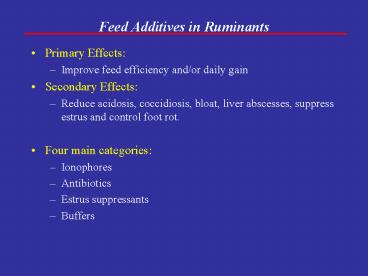Feed Additives in Ruminants - PowerPoint PPT Presentation
1 / 10
Title:
Feed Additives in Ruminants
Description:
energy retention. Reduce digestive upsets = reduced stress = improved animal performance ... protein = ruminal protein shortage. Growing cattle: high-roughage ... – PowerPoint PPT presentation
Number of Views:776
Avg rating:3.0/5.0
Title: Feed Additives in Ruminants
1
Feed Additives in Ruminants
- Primary Effects
- Improve feed efficiency and/or daily gain
- Secondary Effects
- Reduce acidosis, coccidiosis, bloat, liver
abscesses, suppress estrus and control foot rot. - Four main categories
- Ionophores
- Antibiotics
- Estrus suppressants
- Buffers
2
- It is essential to abide by recommended feeding
levels with any feed additive - Violation of FDA guidelines
- Reduced animal performance
3
Ionophores
- Results in selection of certain microorganisms in
the rumen - Inhibits or depresses certain MCO growth
- Alters rumen fermentation
- Usually ? propionate production
4
Effects of ionophores
- Improve efficiency of energy metabolism by
changing the VFA profile ? energy lost in
fermentation - ? energy retention
- Reduce digestive upsets reduced stress
improved animal performance
5
- Too high of a level of ionophore can reduce
cellulolytic bacteria - ? fiber digestion
- ? rumen protein ruminal protein shortage
- Growing cattle high-roughage diets
- Improved daily gain (5 - 15) feed efficiency
(8 - 12) - Finishing cattle high-concentrate diets
- Improved feed efficiency (6 - 8) and subtle
improvement in daily gain (1 - 3) - Prevention or control of bloat and acidosis
6
- Common ionophores on the market
- Rumensin? (Monensin Sodium)
- 20 - 30 g/ton
- Bovatec? (Lasalocid Sodium)
- 10 - 30 g/ton
- 1 mg/2.2 lb. of BW control of coccidiosis
- Cattlyst? (Laidlomycin Propionate Potassium)
- 5 - 10 g/ton
7
Antibiotics
- The primary reason to feed antibiotics to
ruminants is to control liver abscesses, foot rot
secondary infections/diseases as a result of
shipping stress - Control of liver abscesses is the primary reason
to continuously feed antibiotics - Cattle on high grain diets
- ? episodes of acidosis ? liver damage and
infection - The greater the severity of liver abscesses, the
greater the reduction in growth performance
8
- Chlortetracycline
- Aureomycin, Aureo S700
- Numerous recommendations based on production
level of animal - 48 hour withdrawal time
- Oxytetracyline
- Terramycin
- 75 mg/hd/d ? liver abscesses
- 0.5 - 2.0 g/hd/d ? shipping fever complex
- Feed 3 - 5 days before after arrival
- 7 day withdrawal time
- Tylosin
- Tylan
- 8 - 10 g/t or 60 - 90 mg/hd/d
- Cleared for use with Rumensin and/or MGA
9
Estrus Suppressants
- Melengesterol Acetate (MGA)
- Synthetic hormone similar in structure and
activity to progesterone - Feedlot heifers
- Suppress estrus ? growth performance
- 3 - 7 for ADG FE
- ? injury, ? dark cutters, ? energy expended by
chasing heifers - 0.25 - 0.50 mg/hd/d
- Cleared for use with Rumensin, Bovatec Tylan
- 48 hour withdrawal period
10
Buffers
- Added to the diet to aid in resisting pH changes
of the rumen when acids are present - Reduces incidence of acidosis on high grain diets
- Improves fiber digestion in corn silage diets
- Performance is variable
- -2 - 5 improvement in ADG FE
- Sources
- Sodium Bicarbonate 0.75 - 1.5 diet DM
- Limestone 1.0 diet DM
- Sodium Bentonite 1 - 2 diet DM
- Magnesium oxide 0.5 - 0.75 diet DM































